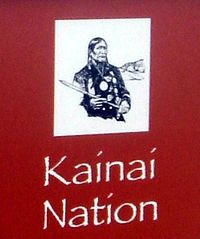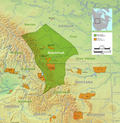Kainai Nation

The Kainai Nation (or Káínawa, or Blood Tribe) is a First Nations band government in southern Alberta, Canada, with a population of 1000 members in 2005.[1]
Akáínaa translates directly to "Many Chief" (from aká - "many" and nínaa - "chief") while Káína translates directly to "Many Chief people." The enemy Plains Cree called the Kainai Miko-Ew - "stained with blood", i.e. "the bloodthirsty, cruel", therefore, the common English name for the tribe is the "Blood tribe."
The Kainai speak a language of the Algonquian linguistic group; their dialect is closely related to those of the Siksika and Peigan. They are one of three nations comprising the Blackfoot Confederacy.
At the time treaties such as Treaty 7 were signed, the Kainai were situated on the Oldman, Belly, and St. Mary rivers west of Lethbridge, Alberta. The Kainai reserve Blood 148 is currently the largest in Canada with 3,852 inhabitants [2] on 1,414.03 km² and is located approximately 200 kilometres south of Calgary. As of December 2013, the Kainai Nation had a total registered population of 11,791 people.[3]
Economy
The Kainai nation is engaged in diverse enterprises and they trade with domestic and international partners. Ammolite mining for example provides a rare highly demanded gem mineral to Asia for Feng Shui. Ammolite is currently known only to be found in the Bearpaw Formation as unique conditions of prehistoric were optimal for the fossilization of marine life into Ammolite.[4] Over the years, mining operations have uncovered several oceanic dinosaur fossils which have been stored for study at the Royal Tyrrell Museum however they belong to the Kainai nation.(Lawrynuik)[5]
Government
Band council
The Kainai Nation is governed by an elected council of twelve to fifteen, with one chief. The term of office is four years. Historical chiefs of the Kainai are below:
- Last of the Hereditary Chiefs Traditional Chief Jim Shot Both Sides (1956–1980)
- Chief Chris Shade (1996–2004)
- Chief Charles Weasel Head (2004–2016)
Blood Tribe Councillors (2019)[6]
- Dorothy First Rider (Itoomomaahkaa – Front Runner)
- Floyd Big Head (Piitaika’tsis – Eagle Arrow)
- Kyla Crow (Komiikakato’saakii – Round Star Woman)
- Martin Heavy Head (Ponokaiksikksinamm – White Elk)
- Joanne Lemieux (Aahkoyinnimaakii – Pipe Woman)
- Robin Little Bear (Soyiikayaakii – Mink Woman)
- Kirby Many Fingers (Apanssaapii – Counting Coup)
- Hank Shade (Aapiisii – Coyote)
- Lance Tailfeathers (Naatsikapoikkanaa – Two Stars Shining)
- Tim Tailfeathers (Naato’kisikapiohkitopiyi – Rides Two Grey Horse)
- Marcel Weasel Head (Niitsayoohkiitohkitopiyi)
- Franklyn White Quills (Makoyaapii – Wolf Old Man)
Police force
In pre-treaty times, the iikunuhkahtsi were a society responsible for the punishment of misdeeds. The Blood reserve is currently policed by the Blood Tribe Police, with 31 officers in 2015.
-
Chief of the Blood Indians, War chief of the Piekann Indians and Koutani Indians by Karl Bodmer
-
Stsimaki (Reluctant-to-be-woman) - Blood by Edward S. Curtis
-
Apio-mita White Dog - Blood
-
Niukskai-Stamik Three Bulls - Blood
-
Kaistosinikyi Kill-For-Nothing - Blood
-
Atso Tohkomi Call-on-All-Sides - Blood
-
Astanighkyi Come-Singing - Blood
-
Astanighkyi Come-Singing - Blood
-
Makoyepuk Wolf-Child - Blood
-
Makoyepuk Wolf-Child - Blood
-
A Blood Horseman
Notable people
- Chief Red Crow - 1887 Treaty Number Seven Chief
- Byron Chief-Moon - performer and choreographer
- Eugene Creighton (Owns Many Horses)
- Eugene Brave Rock - actor and stunt man
- Faye HeavyShield - artist
- Jerry Potts
- Pete Standing Alone
- Wayne Plume (1931-2015) - Standoff Mayor 1990's-early 2000's http://cornerstonefuneralhome.com/index.php/obituaries/?&obitID=2479
Media
In 1960, the Kainai and their sacred Sun Dance were featured in the National Film Board of Canada documentary Circle of the Sun. Tribal leaders had been concerned that the Sun Dance might be dying out, and had permitted filming as a visual record.[8][9]
In 2006, community leader Rick Tailfeathers contributed a small ammolite carving of a buffalo skull to the Six String Nation project. The object was permanently mounted on the interior of Voyageur, the guitar at the heart of the project.[10]. Following a presentation about the project in September of 2014 at Tatsikiisaapo'p Middle School, project creator Jowi Taylor was presented with a braid of sweetgrass by school principal Ramona Big Head. The braid resides in the headstock area in the bed of the guitar case.
On National Aboriginal Day in 2011, the NFB released the Pete Standing Alone trilogy, which includes Circle of the Sun, Standing Alone and a 2010 film, Round Up, documenting 50 years of the Kainai Nation as well as the life of elder Pete Standing Alone.[11]
Historical Newspapers

- Kainai News -- The Kainai News (1968-1991) was one of Canada's first aboriginal newspapers and instrumental in the history of aboriginal journalism in Canada. It was published in southern Alberta by the Blood Indian Tribe and later by Indian News Media. Content focused on a range of local issues within the reserve as well as national issues such as the Indian Act, the Whitepaper and Bill C-31. Of particular significance are editorial cartoons by Everett Soop which were a regular feature of the newspaper. Its first editor way Caen Bly, granddaughter of Senator James Gladstone.[12]
- Sun Dance Echo -- The Sun Dance Echo (1964-1966) was a predecessor to the Kainai News. It was edited by Reggie Black Plume and occasionally contained articles by Hugh Dempsey.
Communities
The Kainai nation communities include:[13]
- Bullhorn
- Fish Creek
- Ft Whoop Up
- Levern
- Moses Lake
- Old Agency
- Standoff
See also
References
- ^ Alberta Municipal Affairs - 2005 Official Population list - Indian Registered Population. December 2005. Retrieved on 24 September 2006.
- ^ Statistics Canada - 2001 Census Aboriginal Population Profile
- ^ Blood Tribe Registered Population - Aboriginal Affairs and Northern Development Canada - "Archived copy". Archived from the original on 2014-02-01. Retrieved 2014-01-23.
{{cite web}}: Unknown parameter|deadurl=ignored (|url-status=suggested) (help)CS1 maint: archived copy as title (link) - ^ Lawrynuik, S (Feb 22, 2017).'It's like nothing else on earth: Rarest of Gemstones fuels boom for Alberta miners'.CBC News, retrieved from http://www.cbc.ca/news/canada/calgary/ammolite-mine-expansion-canada-gems-1.3993105, retrieved on Nov 28, 2017
- ^ Narine, S(2002).Fossil discovered in mining operation, Alberta Sweetgrass 9(11) retrieved from http://www.ammsa.com/publications/alberta-sweetgrass/fossil-discovered-mining-operation, retrieved on Nov 28, 2017
- ^ "Chief and Council". Blood Tribe. Archived from the original on January 24, 2014. Retrieved April 13, 2019.
- ^ "Stu-mick-o-súcks, Buffalo Bull's Back Fat, Head Chief, Blood Tribe by George Catlin". Smithsonian American Art Museum. Retrieved 2012-08-10.
- ^ Rosenthal, Alan; John Corner. New challenges for documentary. Manchester University Press. pp. 90–91. ISBN 0-7190-6899-1.
- ^ Low, Colin; Gil Cardinal. "Circle of the Sun". Curator's comments. National Film Board of Canada. Retrieved 4 December 2009.
- ^ Jowi., Taylor, (2009). Six string nation : 64 pieces, 6 strings, 1 Canada, 1 guitar. Vancouver: Douglas & McIntyre. ISBN 9781553653936. OCLC 302060380.
{{cite book}}: CS1 maint: extra punctuation (link) CS1 maint: multiple names: authors list (link) - ^ Anderson, Kelly (17 June 2011). "NFB celebrates National Aboriginal Day". Realscreen. Toronto. Retrieved 4 July 2011.
- ^ Sanderson, Kay (1999). 200 Remarkable Alberta Women. Calgary: Famous Five Foundation. p. 101.
- ^ Blood Tribe - About Us & Communities listed "Archived copy". Archived from the original on 2014-01-31. Retrieved 2014-01-23.
{{cite web}}: Unknown parameter|deadurl=ignored (|url-status=suggested) (help)CS1 maint: archived copy as title (link)
External links
- Kainai Studies - Post secondary educational entity dedicated to Blackfoot teachings
- Introduction to photo essay from 'Nitsitapiisinni: Our Way of Life' museum exhibit
- Concise description of the Blackfoot tribes
- Blood Tribe Information Web
- Pete Standing Alone Trilogy, National Film Board of Canada
- Brief biography of former chief Roy Fox.
- Kainai News (1968-1991)
- Blackfoot Digital Library
- Blood Tribe page at Treaty 7 Management Corporation website

![Stu-mick-o-súcks, Buffalo Bull's Back Fat, Head Chief, Blood Tribe, 1832 by George Catlin [7]](http://upload.wikimedia.org/wikipedia/commons/thumb/1/17/George_Catlin_-_Buffalo_Bulls_Back_Fat_-_Smithsonian.jpg/99px-George_Catlin_-_Buffalo_Bulls_Back_Fat_-_Smithsonian.jpg)











